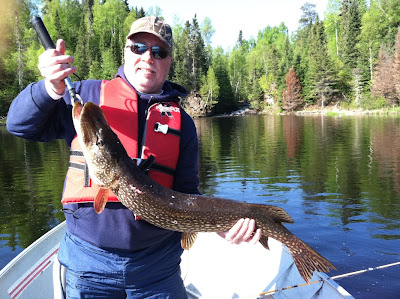This photo taken in 1962 shows just some of the Ojibwa men of Red Lake, Ontario, who worked as guides at Bow Narrows Camp in the early days. I wanted to get this published on the Internet so that their descendents have a record of them. I'm afraid it is likely that there are not other photos of many of these men.
Standing, back row, from left: Frank Paishk, Tony Paishk, Chic King, George Trout, John Duck Strang
Kneeling, front, from left: Danny Cameron, Adam Paishk, Jim Duck Strang
Frank Paishk and his brother, Adam, were born at the site where there is still a cabin at the entrance to West Narrows. Frank built that cabin at what was apparently once a First Nations village. There were several log buildings there when we came to Red Lake in 1960 but they were in bad repair. Frank sawed them up for firewood and brought the logs for the current cabin by towing them behind his canoe, one at a time. I forget the year but it was in the early '60s.
The cabin stands there today, unused since the death of Frank in the '70s and Adam in the '80s. I see it as a memorial to the horrible things the federal and provincial governments did to First Nations people in those days and earlier. The deliberate cultural genocide of these people is a sad chapter in Canadian history. There is too much to say about it in one blog posting but since I've mentioned the cabin, consider this injustice: that cabin was the only home of Frank and Adam but they were forbidden by the government to live there except in the winter when they could use it for trapping. It was the same for all First Nations people. The government wanted them to move to reserves -- called reservations in the U.S. -- which were far away and where there was no prospect of making a living.
Tony Paishk, and his brother Ed, not in this photo, were born on the north shore of Pipestone Bay. There are no cabins there today and I never knew of one. They may have been born in a tent or other structure as their people moved seasonally to follow game.
Jimmy Duck Strang, son of John Duck, apparently was born in Muskrat Bay, located on the west side of what we call Big Red but otherwise known as the Potato Island basin. I was told this by another one of our guides, Joe Keesic, not long before he died a couple of years ago. Joe was born on the big island in Pipestone Bay nearest the narrows. Joe said he was told this by one of his aunts who wanted him to know before she passed on. Joe worked as a navigator on Ministry of Natural Resources water bombers and retired from that position.
Danny Cameron and his brother Larry, had a trapline on Medicine Stone Lake, south of Red Lake.
Not seen in this photo but a man who worked for years at Bow Narrows Camp was Jim Paishk who was considerably older than others in this group. Jim was like a grandfather to me when I was growing up and did more than anyone to bestow upon me a reverence for Nature. He was probably in his late 60s when this photo was taken. He lived to be in his 70s. Jim could recall when his family only had a muzzleloader rifle and when he saw his first white man. He was a wonderful story teller.
Jim would not use a firearm because when he was a young man he mistook his father's black hat for a moose and shot at it. The bullet went through the hat, right above his father's head. This earned Jim the nickname "Peepsite," but it was a name he didn't like and we never called him that.
These men knew the bush between Red Lake and the Manitoba border like the backs of their hands. There was no lake they had not been to. They knew of trails that were probably thousands of years old.
I want their descendents to know what a fine people they all were. They were the hardest-working, most-honest and decent people you could imagine. As an example, my parents would leave me in their care for trips in the bush from the time I was very young. I think my parents knew that I couldn't be in better hands.
It was a great honour for me a couple of years ago to have a First Nations elder, Josephine King, come visit me to see if I remembered some of the cultural practices of the Ojibwa people at our end of the lake.
She brought with her a grandson, Ronald, so that he could carry the knowledge with him in his life. I wished I had told him how proud he should be to be a descendent of these clever, resilient, skillful people. Their knowledge of the bush will never be surpassed. They not only survived there, they flourished. The bush was their home.
If they had a creed they never told me as such in so many words but I made up my own from living with them.
"You always have everything you need everywhere you go."
I suppose you can state it more eloquently, perhaps about how the Creator has provided everything for us as long as we are knowledgeable about what is there and that we use it wisely.
With ten thousand years of history behind them, the First Nations people set the example of living sustainably.
Click to go back to our
website
Click to see the latest on the
blog
































